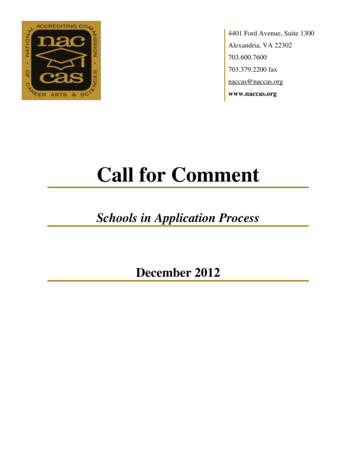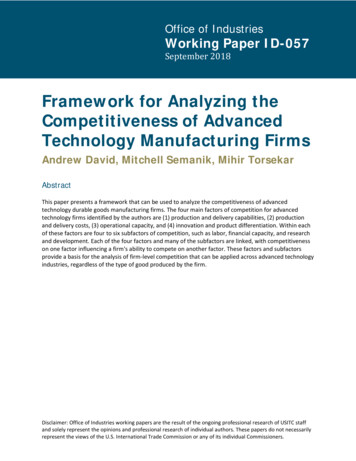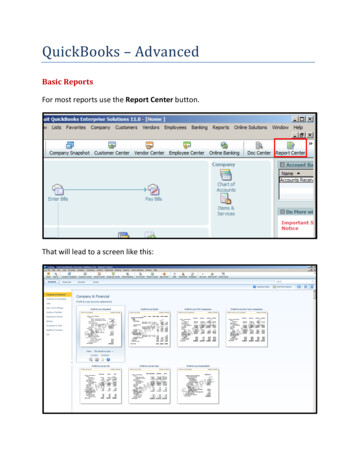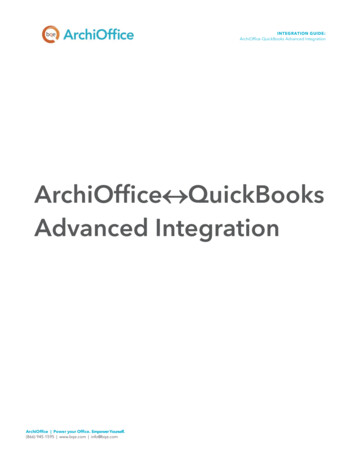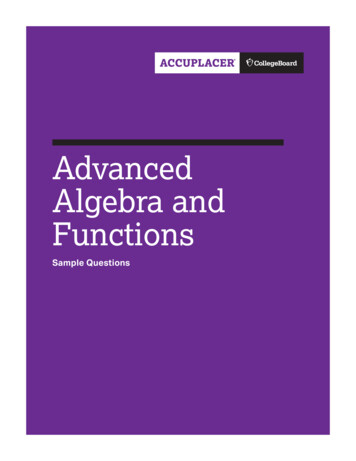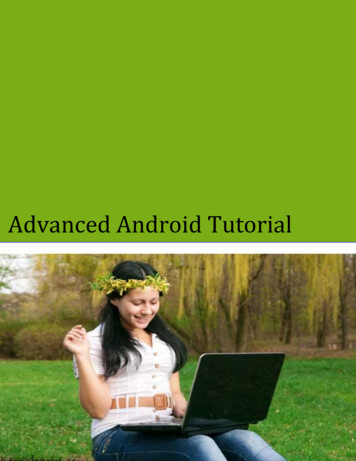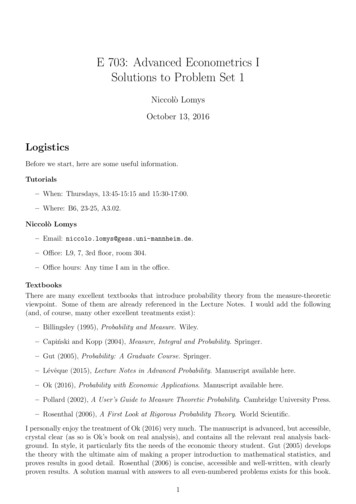
Transcription
E 703: Advanced Econometrics ISolutions to Problem Set 1Niccolò LomysOctober 13, 2016LogisticsBefore we start, here are some useful information.Tutorials– When: Thursdays, 13:45-15:15 and 15:30-17:00.– Where: B6, 23-25, A3.02.Niccolò Lomys– Email: niccolo.lomys@gess.uni-mannheim.de.– Office: L9, 7, 3rd floor, room 304.– Office hours: Any time I am in the office.TextbooksThere are many excellent textbooks that introduce probability theory from the measure-theoreticviewpoint. Some of them are already referenced in the Lecture Notes. I would add the following(and, of course, many other excellent treatments exist):– Billingsley (1995), Probability and Measure. Wiley.– Capiński and Kopp (2004), Measure, Integral and Probability. Springer.– Gut (2005), Probability: A Graduate Course. Springer.– Lévêque (2015), Lecture Notes in Advanced Probability. Manuscript available here.– Ok (2016), Probability with Economic Applications. Manuscript available here.– Pollard (2002), A User’s Guide to Measure Theoretic Probability. Cambridge University Press.– Rosenthal (2006), A First Look at Rigorous Probability Theory. World Scientific.I personally enjoy the treatment of Ok (2016) very much. The manuscript is advanced, but accessible,crystal clear (as so is Ok’s book on real analysis), and contains all the relevant real analysis background. In style, it particularly fits the needs of the economic theory student. Gut (2005) developsthe theory with the ultimate aim of making a proper introduction to mathematical statistics, andproves results in good detail. Rosenthal (2006) is concise, accessible and well-written, with clearlyproven results. A solution manual with answers to all even-numbered problems exists for this book.1
Lévêque (2015) is roughly at the same level of our course. Lévêque’s notes are short (but not simplistic) and accurate (but without excessive technicalities), and so they are a good read. Capińskiand Kopp (2004) is particularly useful if you lack a solid real analysis background. It has solutionsto all problems and good intuitive explanations. Billingsley (1995) is encyclopedic, but I do not findit too “user friendly” or particularly suited for self-study. Pollard (2002) offers an interesting anddeep point of view, but the treatment is a bit idiosyncratic. I would not recommend it as the mainreference unless you are taking a probability course with David Pollard.For the mathematical statistics and the introduction to the linear regression model that we coverin this course, I find the following references useful (in addition to those listed in the Lecture Notes):– Casella and Berger (2001), Statistical Inference. Duxbury.– Hansen (2016), Econometrics. Manuscript available here.– Rohatgi and Saleh (2001), An Introduction to Probability and Statistics. Wiley.Grading Policy for Problem SetsEach problem set will contain six exercises and will be graded out of 100 points. Two exercises willbe starred, while the others will not. The two starred exercises will account for 60 points and willbe graded (almost) as carefully as your exam will be. This means that you will receive an accuratefeedback on them, so that you can get an idea about what we expect from you at the exam. However,this also means that points will be cut any time a step of your solution is not sufficiently motivatedor your argument is loose. While I will be moderately tolerant at the beginning of the term, I willbecome increasingly less so over time, so that you can adjust before the final exam. The remainingfour exercises will account for 10 points each and will be graded in a coarse way: 10 points if youprovide a satisfactory answer with only minor flaws; 6 points if your solution contains one or moremajor problems; 2 points if you barely attempt to solve the exercise; 0 points if you do not answerat all.2
PreliminariesThroughout our exercise sessions, we will stick to the following conventions.1. A set is a collection of objects we call elements. A class is a set of sets, and a family is a setof classes. Please, try to be consistent.2. The set of natural numbers is N WD f1; 2; : : : g, i.e., we exclude zero.3. We say that two nonempty sets A and B in some universal set U are numerically equivalent,or that A and B have the same cardinality, or that A and B have the same cardinal number,if there exists a bijection f W A ! B. In this case, we write A card B.Let N be the set of natural numbers, and set Nn WD f1; 2; 3; : : : ; ng for any n 2 N. For anyA U we say:(a) A is finite if A card Nn for some natural number n;(b) A is infinite if A is not finite;(c) A is countably infinite if A card N;(d) A is countable if A is either finite or countably infinite;(e) A is uncountable if A is not countable.The empty set is considered to be finite and its cardinal number is zero.SS4. The symbols 1i D1 andi 2N are used interchangeably to denoted countably infinite unions.An analogous observation applies to countably infinite intersections.5. The terms “algebra” and “field,” as well as “ -algebra” and “ -field,” are used interchangeably.Algebras and -AlgebrasDefinition 1. Let be a nonempty set. A nonempty class A of subsets of is called an algebra(or field) on if(i) ; 2 A ;(ii) n A 2 A for all A 2 A ;(iii) A [ B 2 A for all A; B 2 A .We say that A is a finite algebra on if it is an algebra on such that jA j 1.In words, an algebra on a nonempty set is a nonempty class of subsets of that has the emptyset as one of its elements and is closed under complementation and taking pairwise (and thus finite1 )unions. A finite algebra on is one that contains finitely many elements. Clearly, any algebra on afinite set is a finite algebra on that set.Definition 2. Let be a nonempty set. A nonempty class A of subsets of is called a -algebra(or -field) on if(i) ; 2 A;(ii) n A 2 A for all A 2 A;1Quiz: Why? In particular, why finite and not countably infinite unions?3
(iii)S1nD12 A whenever An 2 A for each n D 1; 2; : : : .Any element of A is called an A-measurable set in . If A is a -algebra on , we refer to thepair . ; A/ as a measurable space.That is, a -algebra on is a nonempty class of subsets of that has the empty set as one of itselements and is closed under complementation and taking countably infinite unions. Note that thereis no difference between an algebra and a -algebra when the ground set under consideration isfinite.2Interpretation. We interpret the fundamental set as the set of all possible outcomes (or realizations) ! of a given experiment whose result is uncertain. We call the sample space. Giventhe sample space , it is important to describe what information one has on the outcomes of theexperiment. This notion of information is captured by the mathematical notion of -algebra. Thesets belonging to a -algebra A on are the events that one can decide on whether they happenedor not, given the information A. That is, A is an event if and only if A 2 A. If one knows theinformation A, then one is able to tell which events of A (D subsets of ) the realization of theexperiment ! belongs to. One may define many different -algebras on a given sample space, sowhat an “event” really is depends on the model one chooses to work with. We cannot, however,be completely arbitrary when specifying a model because the notion of -algebras imposes somerestrictions. First, we need to be able to say that nothing happens, which requires ; 2 A. Second,if A is an event, then we need to be able to talk about this event not occurring, that is, to deem theset n A also as an event. This requires A be closed under complementation. Finally, we wish tobe able to talk about at least one of countably many events occurring, and this requires A be closedunder taking countable unions. Besides, the last two properties warrant that we can view “countablymany events occurring simultaneously” as an event as well.Exercise 1 (Some Basic Properties of -Algebras)Let A be a -algebra on a nonempty set . Show that:(a) 2 A;(b) If A1 ; : : : ; An 2 A for some n 2 N, thenTnkD1Ak 2 A;(c) If A; B 2 A, then AnB 2 A.SolutionFor any A , define Ac WD n A.(a) Since A is a -algebra on , ; 2 A (by property (i) of -algebras) and ;c 2 A (by property(ii) of -algebras). Observing that ;c D completes the proof. (b) We first show that A is closed under finite unions. That is, A1 ; : : : ; An 2 A for some n 2 N H)n[Ak 2 A:(1)kD1Let A1 ; : : : ; An 2 A. For any natural number m n, define Am WDS1;. By property (i) of -algebras, Am 2 A for any such m. By property (iii) of -algebras, kD1 Ak 2 A. Since!!1n1nn[[[[[Ak DAk [Al DAk [ ; DAk ;kD12kD1lDnC1kD1kD1Quiz: Is there any redundant property in our definitions of algebra and -algebras? If so, which one and why?4
the claim follows.We now use the previous claim to show that n\ A1 ; : : : ; An 2 A for some n 2 N H)Ak 2 A:kD1Let A1 ; : : : ; An 2 A. Property (ii) of -algebras gives Ac1 ; : : : ; Acn 2 A. By (1),n[Ack 2 A;kD1and so, again by property (ii) of -algebras,n[!cAck2 A:(2)kD1By De Morgan’s laws,n[!cAckkD1Dn\kD1 cAckDn\Ak :(3)kD1The desired result follows from (2) and (3). (c) First, note that A n B D A \ B c . Since A is a -algebra and B 2 A, by property (ii) of -algebras we have B c 2 A. As -algebras are closed under pairwise intersections (Exercise1-(b)) and A; B c 2 A, A \ B c 2 A. The desired result follows. Remark. Algebras are closed under pairwise unions (by definition) and under pairwise intersections(by De Morgan’s laws); by induction, we have that algebras are closed under finite unions and intersections. -algebras are closed under countably infinite unions (by definition) and under countablyinfinite intersections (by De Morgan’s laws). By (1), -algebras are closed under pairwise unions, andso any -algebra on a nonempty set is an algebra on . It follows that -algebras are closed undercountable unions and intersections, and that properties (a) and (c) in Exercise 1 hold for algebras aswell. We will use these facts as a routine during the course.Exercise 2Solve the following problems.(a) Let WD f1; 2; 3g. Explicitly describe the family of all possible -algebras on .(b) Let N be the set of natural numbers and defineA WD fA N W min fjAj ; jN n Ajg 1g ;where jAj denotes the cardinal number of A N. Is A an algebra on N? A -algebra? Justifyyour answers.(c) Let be a nonempty set and defineA WD fA W either A or n A is countableg :Is A an algebra on ? A -algebra? Justify your answers.5
Solution(a) The possible -algebras on WD f1; 2; 3g are:andA1A2A3A4A5WD f;; g ;WD f;; f1g ; f2; 3g ; g ;WD f;; f2g ; f1; 3g ; g ;WD f;; f3g ; f1; 2g ; g ;WD f;; f1g ; f2g ; f3g ; f1; 2g ; f1; 3g ; f2; 3g ; g :Hence, the family of all possible -algebras on isfA1 ; A2 ; A3 ; A4 ; A5 g :Remark. How do we know we can stop looking for -algebras on ? Since all -algebras on are subsets of P . / D A5 , we can start from A5 and check which of its proper subsets are -algebras on . In our example, the cardinal number of is just 3, so this is a simple task.In general, it can be shown that on a nonempty finite set there are as many -algebras aspartitions of . The total number of partitions of a set with cardinal number n is the Bellnumber Bn . Bell numbers satisfy the recursion!nXnBnC1 DBk ; with B0 D B1 D 1:kkD0The first several Bell numbers are B0 D 1, B1 D 1, B2 D 2, B3 D 5, B4 D 15, B5 D 52, andB6 D 203. (b) A is the class of all subsets A of N such that either A or Ac WD N n A is finite. We now showthat A is an algebra, but not a -algebra, on N. It is called the cofinite algebra on N.Claim 1. A is an algebra on N.Proof. First, since ; is finite, ; 2 A. Second, let A 2 A; if A is finite, then Ac 2 A becauseits complement .Ac /c D A is finite; if Ac is finite, then Ac 2 A because it is finite. Third, letA; B 2 A. Then, we have four cases:(i) A is finite and B is finite. Then, A [ B is finite (as the union of finite sets is finite), andso it is in A.(ii) A is finite and B c is finite. Then, .A [ B/c D Ac \ B c is finite (as Ac \ B c B c andevery subset of a finite set is finite), and therefore A [ B 2 A.(iii) Ac is finite and B is finite. Then, .A [ B/c D Ac \ B c is finite (as Ac \ B c Ac andevery subset of a finite set is finite), and therefore A [ B 2 A.(iv) Ac is finite and B c is finite. Then, .A [ B/c D Ac \ B c is finite (as Ac \ B c Ac andevery subset of a finite set is finite), and therefore A [ B 2 A.This completes the proof that A is an algebra on N.Claim 2. A is not a -algebra on N.Proof. We have f2ng 2 A for each n 2 N, but [n2N f2ng D f2; 4; : : : g 62 A (as the set of evennatural numbers is countably infinite, and so is the set of odd natural numbers, which is itscomplement in N). So A is not closed under taking countably infinite unions. 6
(c) We show that A is a -algebra, and hence an algebra, on . It is called the cocountable -algebra on .For any A , let Ac WD n A. First, since ; is finite, it is countable, and so it is in A.Second, let A 2 A; then, either A or Ac is countable, implying that either Ac or .Ac /c D A iscountable; hence Ac 2 A. Third, suppose that An 2 A for each n 2 N. There are two cases:S(i) An is countable for each n 2 N. In this case, Sn2N An is countable, as the countable unionof countable sets is countable, and therefore n2N An 2 A. cSAn is countable and therefore(ii) Acj is countable for some j 2 N. In this case,n2N cSSis countable, note the following:n2N Ann2N An 2 A. To see that1.0!c[AnD Acj \ @n2N1\Acn A Acj ;n2Nnfj gwhere the equality follow by De Morgan’s laws and the set inclusion by the propertiesof intersection;2. Every subset of a countable set is countable. Remark. Let A be the cocountable -algebra on a nonempty set . We can show thatA D P . / if and only if is countable. You can prove it as an exercise.Probability MeasuresDefinition 3. Let . ; P / be a measurable
the theory with the ultimate aim of making a proper introduction to mathematical statistics, and proves results in good detail. Rosenthal (2006) is concise, accessible and well-written, with clearly proven results. A solution manual with answers to all even-numbered problems exists for this book. 1
